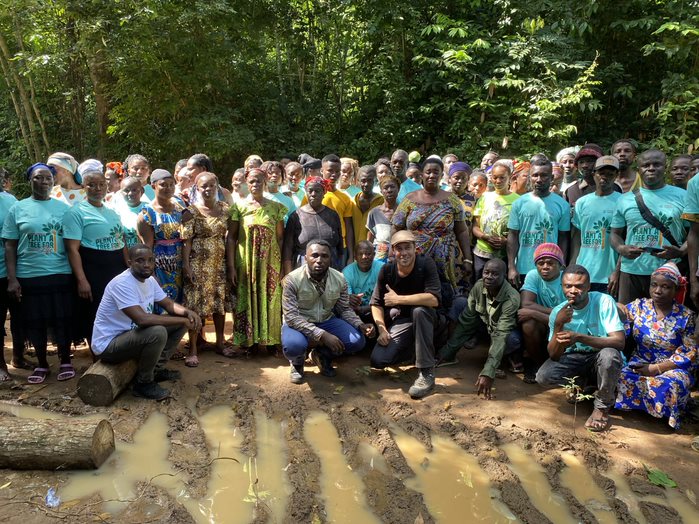By Florence Afriyie Mensah
Akotaa (Ash), Oct.12, GNA – Foundation Franklinia, a Switzerland-based organisation, focused on the conservation of threatened tree species, has commended Ghana for efforts to restock, conserve and protect indigenous tree species in the country’s forest reserves.
Mr Olivier Hasinger, Grant Manager of Fondation Franklinia, who gave the commendation, said conserving and protecting indigenous tree species from extinction was key in safeguarding the forest and its ecosystem.
He was speaking to the Ghana News Agency after a tour of the Asenanyo Forest Reserve at Akotaa in the Atwima-Mponua District.
The Asenanyo Forest Reserve is one of the project sites, where the Institute of Nature and Environmental Conservation (INEC), is supporting farmers to plant and restock the African teak (Krokrodua), an endangered tree species, in the forest reserve.
The “Conservation of African Teak (Pericopsis elata) project in Ghana”, which was launched by INEC in 2020, with funding support from the Fondation Franklinia, aimed at restocking, conserving and protecting the African teak species.
Teak, which has huge commercial and medicinal value, serves as a protector of forest animals of all kinds from extinction in forest reserves.
The project is being implemented in the Asenanyo forest reserve and the Afram Headwater Reserve at Kwapanin, near Offinso in the Ashanti region.
Mr Hasinger expressed great satisfaction with the work done by INEC in the last two years and said, “this is the type of exemplary project we really like to support as a Foundation that is really focused on the conservation of threatened trees and the forest.”
“In fact, I have been touched by the passion and dedication of the community members, forest managers and the Institute of Nature and Environmental Conservation (INEC) – who are implementing the project, he told the Ghana News Agency at the project site.
He said such dedication and passion for long-term conservation were key in safeguarding the ecosystem.
Trees, Mr Hasinger noted, were key species in the ecosystem that provided the habitat for all the biodiversity that depended on the forest, while at the same time, providing a lot of ecosystem services to the people.
There was, therefore, the need for conscious efforts by the people to protect the forest and forest products.
“If you have a healthy forest with diverse trees, it has multiple benefits such that it will be resilient to climate change as well as providing clean water for everyone who lives around”, he emphasized.
Mr Hasinger indicated that the African teak was currently listed as endangered on the International Union for Conservation of Nature (IUCN) Red List.
That was why his outfit saw the need to support INEC to execute the plan of restoring the species back in the forests.
Madam Theresa Mensah, one of the beneficiary farmers, told the GNA that the project had really helped most farmers in the area to cater for themselves and their families in the last two years.
She said when lands were apportioned to them to farm in the forest and protect the newly planted African teak, she took her farming seriously and planted plantain and cocoyam.
“Now see me, I am a happy woman, I get food to eat, I am able to send my wards to better schools in the bigger communities nearby”, she remarked.
Mr Daniel Akwasi Brantuo, another farmer, said “if the project was not brought to the Akotaa community, we would have been dead from hunger and poverty.
This is because not all of us can go to school and learn, so farming has helped me to be self-reliant.
I am still planting my food crops and making money out of it “, he explained and appealed to the authorities to make land available in the forest reserve for them to practice sustainable farming.
Mr David Amaning Kwarteng, the Director of INEC, said the organization had in the last two years planted 140,000 trees of African teak in the Asenanyo Forest Reserve and Afram Headwaters Reserve at Kwapenin near Offinso.
He said the project supported farmers to clear the land, manage weeds and other post-planting management activities.
Mr Kwarteng said the survival rate of the tree, which took about two decades to mature, had so far been more than 50 per cent and was hopeful the percentages would increase as the years go by.
He said one key component was that INEC worked together with the Forestry Commission and the communities to protect the existing trees.
According to him, there had been no record of the Pericopsis species being cut down since the inception of the project in the forest reserves.
Mr Kwarteng expressed worry over the illegal felling of Odum, Wawa and Mahogany species, which were also on the verge of extinction, and pledged to continue to mobilize efforts with key stakeholders to protect these species and other indigenous ones in the long term.
Mr Daniel, Peprah, Forest Manager, Asenanyo Forest Reserve, said the project had helped foresters to understand the growth rate of the species according to the different spacing regimes and commended INEC for initiating the project in the reserve.
GNA
